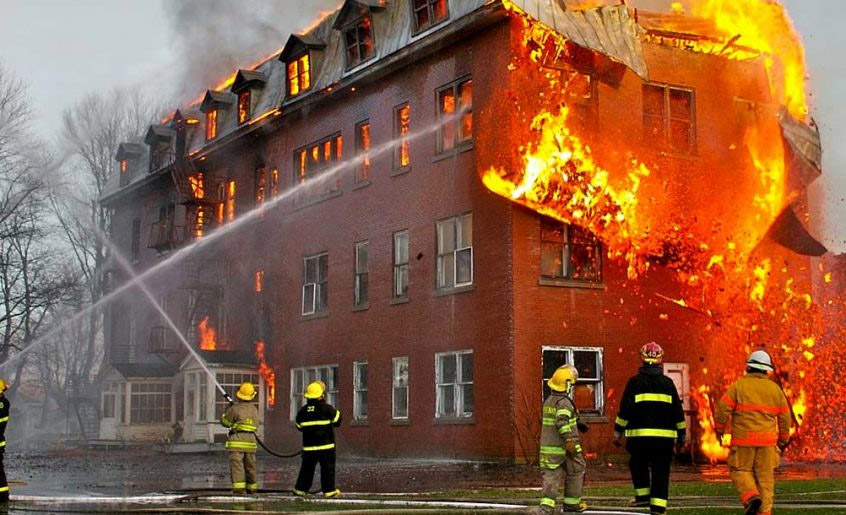Is 'CHALTA HAI' Costing Lives?
Over 25,000 Fire Deaths a Year.

India loses over 25,000 lives every year due to firerelated incidents. That’s nearly 70 deaths a day — a staggering, heart-wrenching statistic buried in the back pages of annual reports and news scrolls. Yet, fire safety continues to be treated as an afterthought in most Indian buildings.
Why? The answer lies in a dangerous blend of ignorance, indifference, and a cultural mindset we’ve grown numb to — the infamous “Chalta Hai” attitude.
Playing With Fire
From the charred remains of a hospital ward to the blackened ruins of a coaching center, every major fire tragedy brings a flood of headlines, hashtags, and hollow promises. Then, silence. No lessons learned. No real reform.
Buildings continue to rise — residential towers, schools, shopping malls, multiplexes — with little regard for basic fire safety norms. Emergency exits are blocked. Fire extinguishers gather dust. Smoke alarms never beep — because they were never installed. In a nation obsessed with infrastructure, we’ve forgotten the people who use it
Is It Ignorance — Or Willful Neglect?
It’s easy to blame “lack of awareness, ” but that excuse has worn thin.
Developers know the fire safety provisions in the National Building Code of India (NBC) and local fire department mandates. Facility managers are aware that fire drills are required. Residents understand that a single short circuit can turn an entire floor into a death trap.
Yet, these precautions are skipped. Delayed. Ignored. Not because we don’t know — but because we believe we can get away with it.
Chalta Hai”: The Silent Killer
The “Chalta Hai” attitude — that casual resignation, that willingness to compromise — is perhaps the most insidious barrier to safety.
- No fire drill this year? “Kya farak padta hai.”
- Exit door jammed with junk? “Abhi toh koi problem nahi hai.”
- Sprinklers non-functional? “Kabhi fire hua hi nahi.”
This mindset isn’t just apathetic — it’s deadly. It transforms everyday negligence into large-scale tragedy. Every fire death is not just a result of bad luck — it is a consequence of years of systemic compromise
Codes Without Consequences
India has comprehensive fire safety codes. But the lack of enforcement turns them into toothless documents.
- Fire safety certificates (NOCs) are sometimes issued without real inspections.
- Many buildings continue to operate without renewal, audits, or compliance.
- Even hospitals, schools, and government buildings lack fire exits or smoke detection systems.
This regulatory vacuum emboldens negligence. When there’s no penalty, why follow the rules?
Who Is Responsible? Everyone
Yes, builders cut corners. Yes, governments are slow to act. But residents, employees, parents, and tenants too must share the blame.
- Did you ever ask your landlord if your apartment has fire detection?
- Did your office conduct a fire drill last year?
- Can your family operate a fire extinguisher?
Fire safety isn’t someone else’s job. It is everyone’s responsibility — and unless we all demand it, nothing will change.
From Checklist to Culture
It’s time to shift the narrative. Fire safety must become a core part of our building culture, not just a formality to tick off for approval.
We need:
- Strict enforcement of fire safety codes — with criminal liability for violations
- Public awareness campaigns that don’t end after a disaster.
- Fire safety education in schools, offices, and housing societies.
- Regular drills and audits that go beyond lip service.
No More Excuses. No More Deaths
- India cannot afford another Rajkot gaming zone fire.
- Another Mundka factory blaze. Another Kamala Mills inferno.
- The cost of “Chalta Hai” is too high — 25,000 lives too high.
- We don’t need more laws. We need more accountability. We need more outrage.
- Above all, we need to care — before the flames rise.
Every Indian Must Wake Up
Fire safety is not the job of a few — it is a collective responsibility.
Every citizen, parent, teacher, employee, and student must understand the basics of prevention and preparedness.
It’s time to include fire safety in school curriculums, just like we teach first aid or traffic rules.
Our children deserve not just smart classrooms, but safe ones. Let’s build a future where fire safety is second nature — not a second thought.
About the Author :
K.P. Dominic is a seasoned expert in Fire, Life Safety, and Infrastructure Protection, with over 36 years of industry leadership. He is the Founder of organizations like NFE, FOCUS, and FSAI and actively contributes to shaping India's fire safety codes through the National Building Code committees.
As the Managing Director of Blue and Gray and the driving force behind Lifeline Equipment International, Dominic champions affordable evacuation solutions to ensure no one is left behind during emergencies. His mission is simple: Safer buildings. Inclusive evacuation. Better lives.